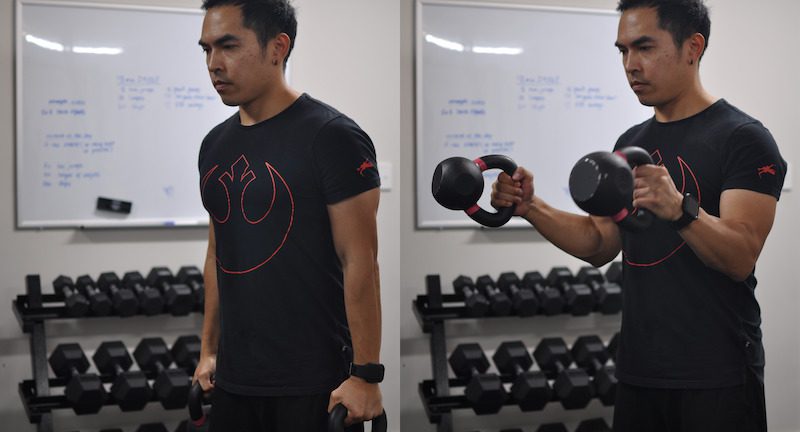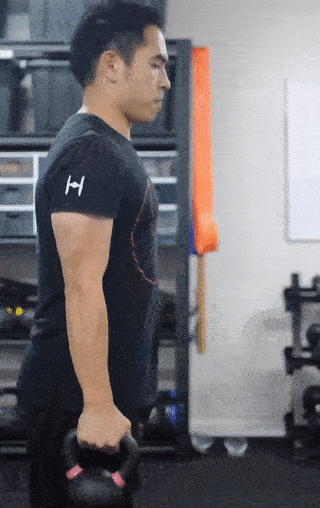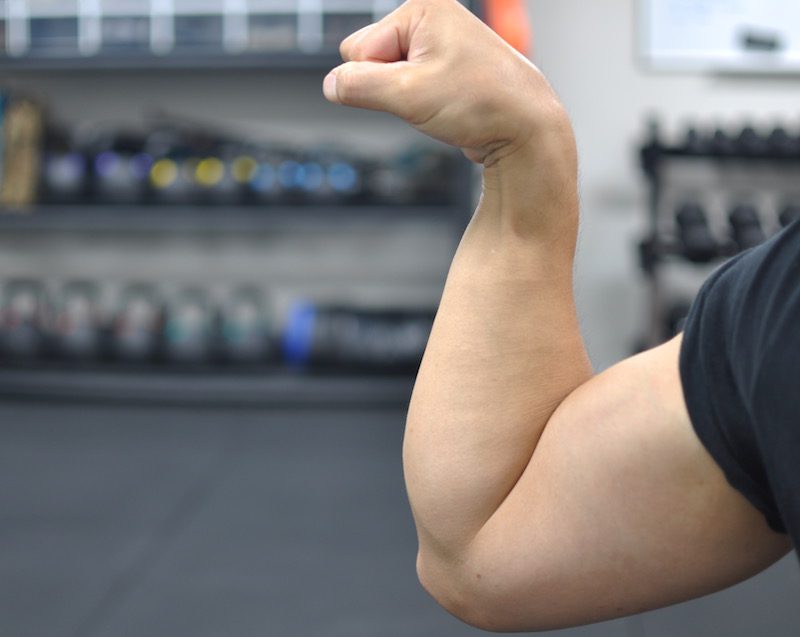
The best online fitness resource you'll ever need. We filter out the BS to ensure you meet your health and fitness goals!

The best online fitness resource you'll ever need. We filter out the BS to ensure you meet your health and fitness goals!

Kettlebell hammer curls are one of the more interesting of the hammer curl variations. The hammer curl motion stays the same; however, the kettlebell presents some challenges… some positive, some not so positive.

Kettlebell hammer curls, as their name suggests, requires the use of a kettlebell instead of a dumbbell or other specially-designed handle for cables or barbells. What makes it so interesting is that the bulk of the weight is beyond the hand and not on either side of it.
Consequently, the grip is now heavily involved in maintaining the position of the kettlebell in space, unlike other hammer curl variations where resistance passes through the closed fist.
Kettlebell hammer curls isometrically work the muscles of the forearm, mostly the flexors which are responsible for maintaining grip, as they must stay tightly engaged to keep the kettlebell from falling forward out of the hand.

Because kettlebell hammer curls are still a hammer curl variation, they’ll primarily work brachioradialis muscle, as well as the secondary brachialis and biceps muscles.
In fact, theoretically, a kettlebell will work those muscles more intensely than a dumbbell of the same weight.
Why is this?
To understand it, you must first understand the principles of levers. Levers are simple machines, and the joints in our bodies form levers as they’re acted upon by surrounding muscles that cross them.

A lever “arm” is the segment of the lever that intersects at some point along its length with the fulcrum.
The longer the lever arm beyond its fulcrum, the less mechanical advantage the lever has, meaning more force must be applied to move a load at the other end. Segments of the lever arm are divided into the “effort” arm, and the “resistance” arm.
In the case of a curl, the effort arm is the distance between the fulcrum—the elbow—and the insertion point of the biceps and brachioradialis.
The farther down the arm those tendons insert, the greater the mechanical advantage that person’s upper arm muscles will have. The resistance arm is that portion on opposite the effort arm.
This is how it looks like with a dumbbell:

So now, take a kettlebell:

When you hold a kettlebell, the weight is now farther away from the insertion point of the biceps and because of that, it magnifies the resistance because it lengthens the resistance arm with no change in length to the effort arm. Same effort arm, longer resistance arm.
Regardless of the weight that’s actually written on the weight, you’ve got to work harder to move a kettlebell than a dumbbell that weighs the same.
We’ll get into advantages and disadvantages in a bit.

To do a Kettlebell hammer curl correctly you’ll only need a kettlebell, or two kettlebells if you want to work both arms during the same set.
Low and behold, the kettlebell hammer curl:

Kettlebell hammer curls require excellent form and concentration to do well. Finishing a set without compromising form is tough, mostly because of the temptation to use more weight than the grip can handle for an entire set.

Select kettlebell hammer curls if your objective is to get your forearms some extra work (if they need it) while also working your upper arms.

High rep sets of light kettlebell curls encourage greater blood supply because of the demand of that constant grip, and therefore contribute to lean, vascular forearms. This assumes you don’t have a large amount of superficial body fat to lose.
The longer resistance arm will overload the target upper arm muscles more than a dumbbell. (Why not just select a heavier dumbbell to compensate for the shorter resistance arm? Good question.)
Kettlebell hammer curls also offer a potential larger range of motion than dumbbells. The shape of the kettlebell puts the “bell” above your fist at the top of each rep such that it won’t come in contact with your shoulder.
For that reason, you’re able to bring your fist as far as your body allows toward your shoulder.
Select kettlebell hammer curls if you need to work on your grip, isometrically work your forearms and encourage vascularity of your forearms.
Remember that the forearm muscles receive some degree of work with almost every exercise that’s done, other than a few of the isolation leg exercises.
Be very cautious to not overwork the forearms and invite an overuse injury like tennis elbow or golfer’s elbow. Those nagging injuries take a long time to heal correctly and usually require a lay-off to do so.
In summary, there’s not a large advantage to kettlebell hammer curls beyond what dumbbells offer. The isometric demand on the forearms and its associated benefits (grip endurance and vascularity), and the somewhat longer ROM are two reasons to select kettlebell hammer curls.
Glad I stumbled upon this page. I was looking for some new kettlebell exercises to add to my routine, and never thought of this! Didn’t realize how weak my forearms were. Ouch!
Hi Deb! Yes, this is definitely a kettlebell workout worth adding to the routine!